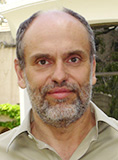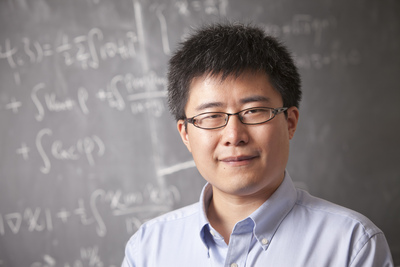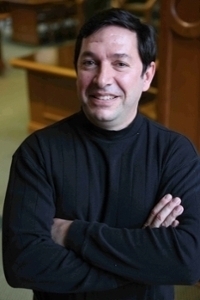SIAM Southeastern Atlantic Section Conference
September 18-19, 2021
Plenary Speakers
Professor Oscar Bruno
Department of Computing and Mathematical Sciences, Caltech
http://www.cms.caltech.edu/people/obruno
Title: Interpolated Factored Green Function Method for Accelerated Solution of Scattering Problems
Abstract: We present a novel "Interpolated Factored Green Function'' method (IFGF) for the accelerated evaluation of the integral operators in scattering theory and other areas. Like existing acceleration methods in these fields, the IFGF algorithm evaluates the action of Green function-based integral operators at a cost of O(N\log N) operations for an N-point surface mesh. Importantly, the proposed method does not utilize previously-employed acceleration elements such as the Fast Fourier transform (FFT), special-function expansions, high-dimensional linear-algebra factorizations, translation operators, equivalent sources, or parabolic scaling. Instead, the IFGF strategy, which leads to an extremely simple algorithm, capitalizes on slow variations inherent in a certain Green-function "analytic factor", which is analytic up to and including infinity, and which therefore allows for accelerated evaluation of fields produced by groups of sources on the basis of a recursive application of classical interpolation methods. In particular, the IFGF method runs on a small memory footprint, and, as it does not utilize the Fast Fourier Transforms (FFT), it is better suited than other methods for efficient parallelization in distributed-memory computer systems. Related integral equation techniques and associated device-optimization problems will be mentioned, including a novel time-domain scattering solver that accurately and effectively solves time-domain problems of arbitrary duration via Fourier transformation in time. (IFGF work in collaboration with graduate student Christoph Bauinger. Device-optimization work in collaboration with former postdoc Constantine Sideris and former students Emmanuel Garza and Agustin Fernandez-Lado. Time-domain work, in collaboration with former graduate student Thomas Anderson.)
Professor Jianfeng Lu
Department of Mathematics, Duke University
https://services.math.duke.edu/~jianfeng
Title: Solving Eigenvalue Problems in High Dimension
Abstract: The leading eigenvalue problem of a differential operator arises in many scientific and engineering applications, such as quantum many-body problems. Conventional algorithms become impractical due to the huge computational and memory complexity from the curse of dimensionality. In this talk, we will discuss some recent works on new algorithms for eigenvalue problems in high dimension based on randomized and coordinate-wise methods and also machine learning approaches. (joint work with Jiequn Han, Yingzhou Li, Zhe Wang and Mo Zhou).
Professor James Nagy
Department of Mathematics, Emory University
http://www.mathcs.emory.edu/~nagy/
Title: MATLAB Tools for Large-Scale Linear Inverse Problems
Abstract: Inverse problems arise in a variety of applications: image processing, finance, mathematical biology, and more. Mathematical models for these applications may involve integral equations, partial differential equations, and dynamical systems, and solution schemes are formulated by applying algorithms that incorporate regularization techniques and/or statistical approaches. In most cases these solutions schemes involve the need to solve a large-scale ill-conditioned linear system that is corrupted by noise and other errors. In this talk we describe and demonstrate capabilities of a new MATLAB software package that consists of state-of-the-art iterative methods for solving such systems, which includes approaches that can automatically estimate regularization parameters, stopping iterations, etc., making them very simple to use. Thus, the package allows users to easily incorporate into their own applications (or simply experiment with) different iterative methods and regularization strategies with very little programming effort. On the other hand, sophisticated users can also easily access various options to tune the algorithms for certain applications. Moreover, the package includes several test problems and examples to illustrate how the iterative methods can be used on a variety of large-scale inverse problems.
The talk will begin with a brief introduction to inverse problems, discuss considerations that are needed to compute an approximate solution, and describe some details about new efficient hybrid Krylov subspace methods that are implemented in our package. These methods can guide users in automatically choosing regularization parameters, and can be used to enforce various regularization schemes, such as sparsity. We will use imaging examples that arise in medicine and astronomy to illustrate the performance of the methods.
This is joint work with Silvia Gazzola (University of Bath) and Per Christian Hansen (Technical University of Denmark).
Professor Juan M. Restrepo
Computer Science and Mathematics Division, Oak Ridge National Laboratory
http://sites.science.oregonstate.edu/~restrepo/
Title: "How Warm is it Getting?" and other Uncertainty Tales
Abstract: In the statistics community “Big Data” science is meant to suggest the combining of inferential and computational thinking. We also speak of big data in the geosciences. However, the problems we pursue are often extreme in the number of degrees of freedom, and in many instances, non-stationary in their statistics. This usually means that we are working with sparse observational data sets, even if the number of observations is large. The Bayesian framework is a natural inferential data assimilation strategy in geosciences, to some extent because the degrees of freedom in the problem vastly outnumber observations but more critically, because the models we use to represent nature have considerable predictive power.
Looking toward the future, two trends appear: we expect improvements in computational efficiency and finer resolutions in models, as well as improved field measurements. This will force us to contend with physics and statistics across scales and thus to think of ways to couple multiphysics and computational resolution, as well as to develop efficient methods for adaptive statistics and statistical marginalization. How this coupling is exploited to improve estimates that combine model outcomes and data will be described in tracking hurricanes and improving the prediction of the time and place of coastal flooding due to ocean swells. Estimating the trend of Earth’s temperature from sparse multi-scale data will be used as an example of adaptivity in time series analysis. The other trend, driven by the success of AI in other realms, is that empirical fidelity of poorly understood processes should play an increasingly important role in climate and weather forecasting. The presentation will conclude with a personal view on where research opportunities arise, within these two thrusts, for collaborations between quantitative and domain scientists.




